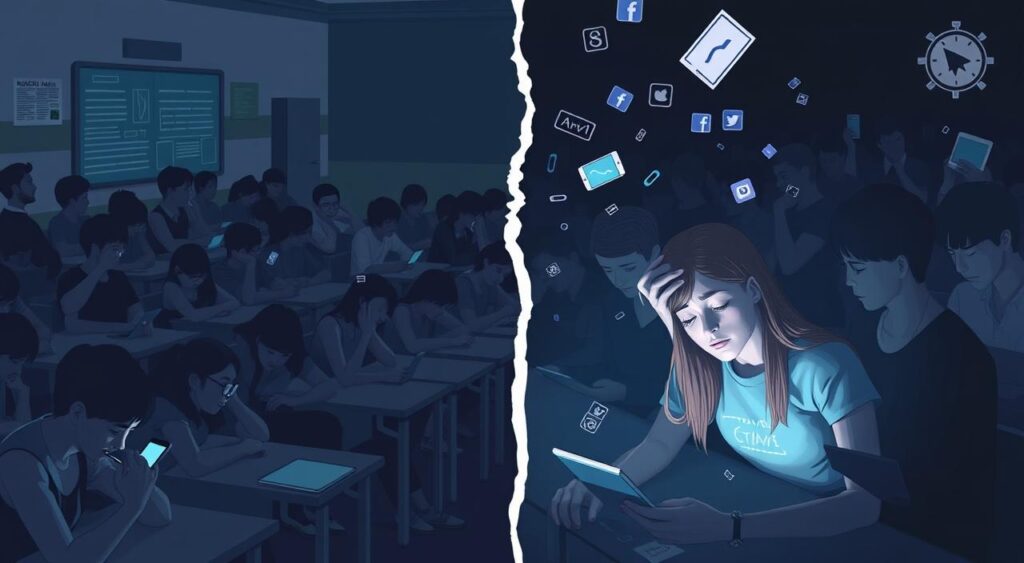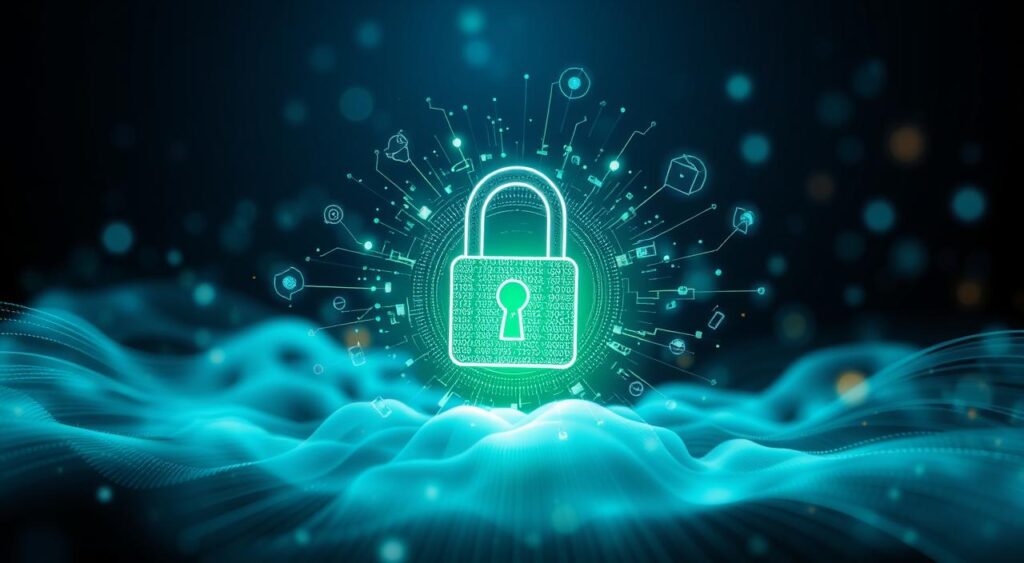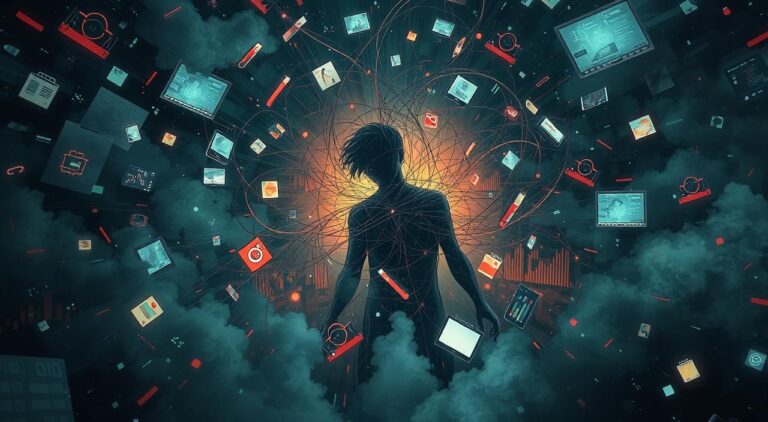
Social media is a big part of many students’ lives today. But it’s not just about staying connected and having fun. It can also harm students’ school work, mental health, and social lives. We need to ask: Are we missing the dangers that hide in our digital world?
Studies show a worrying trend. About 35% of teens aged 13 to 17 use big social media sites like YouTube, TikTok, and Instagram a lot. This can lead to bad grades and mental health problems.
Key Takeaways
- Social media addiction is a growing problem among students, leading to decreased academic focus and performance.
- Cyberbullying and online harassment on social media can have severe emotional and psychological impacts, including depression, anxiety, and even suicidal thoughts.
- Frequent social media use can contribute to body image issues and low self-esteem, especially among vulnerable students.
- Excessive screen time and late-night social media use can disrupt sleep patterns, further hindering academic success.
- Social media’s influence on students’ privacy and digital footprint raises concerns about long-term consequences and online safety.
Understanding the Rise of Social Media Among Students
In recent years, social media use among teens and students has skyrocketed. A 2022 survey of 1,300 teens aged 13-17 found that 95% use social media, with a third using it constantly. This digital engagement has become a big part of their lives, affecting their well-being and growth.
Current Social Media Usage Statistics
Studies show that most high school students prefer YouTube, TikTok, Instagram, and Snapchat. Research also links long social media use to mental health risks in teens. This shows we need to understand social media’s impact better.
Most Popular Platforms Among Students
- YouTube
- TikTok
- Snapchat
Time Spent on Social Media Daily
Students spend varying amounts of time on social media. But, using it for over three hours daily doubles the risk of poor mental health. This highlights the need for a balance in their lives.
| Age Group | Average Daily Social Media Use |
|---|---|
| 8-12 years old | Approximately 40% use social media platforms |
| 13-17 years old | Nearly 95% use social media, with over a third reporting “constant” use |
| 8th and 10th grade students | Around 3.5 hours per day on social media platforms |
Exploring teen social media trends shows it’s a big part of their lives. But, the risks of too much use are real. We must find ways to help them use social media in a healthy way.
Mental Health Challenges and Social Media Exposure
Social media is a big part of our lives now. It has brought mental health issues to teens and young adults. Using sites like Facebook, Instagram, and TikTok too much can cause problems like depression, anxiety, and addiction.
The teenage brain is still growing. This makes teens more likely to be affected by social media. Being on social media a lot can make teens feel more emotional, have trouble focusing, and be more sensitive to likes and comments.
The U.S. Surgeon General says social media can harm young people’s mental health. Research shows teens who spend over 3 hours a day on social media are twice as likely to have mental health issues. These issues include teen depression and anxiety.
The fear of missing out (FOMO) and the need to look perfect online can make teens feel bad about themselves. Cyberbullying and online harassment can make things even worse. They can lead to anxiety and depression.
But social media can also be good for connecting and sharing. It’s important for students to use it wisely. They should limit their screen time, be mindful, and focus on real-life relationships. These steps can help manage the bad effects of social media on mental health.
“The introduction of social media platforms and smartphones has profoundly changed the way young people interact with each other and the world around them. These changes have not all been positive, as we’re now seeing the negative mental health impacts of excessive social media use among teenagers and college students.”
What are the negative impacts of social media on students?
Social media is everywhere in students’ lives, raising worries about its effects on their health and school work. Many studies have shown the bad sides of too much social media for young people.
Immediate Effects on Daily Life
Social media can really mess with a student’s focus and work. Studies say too much time on social media can mess up sleep, harming health. It also causes eye problems, making it hard to study.
Long-term Consequences
One in three teenage girls say Instagram makes them feel worse about their bodies and social media habits. Facebook’s research shows Instagram makes people feel bad about themselves, anxious, and worried they’re missing out (FOMO). These problems can hurt a student’s mental health and self-confidence, leading to more anxiety and depression, especially with cyberbullying.
Risk Factors for Vulnerable Students
Some students are more at risk from social media, like those with mental health issues or social problems. Research links social media to more anxiety and depression, especially with cyberbullying. To help, new ideas like hiding likes and the “all caught up” message are being tried. Tools like onGuard from Netsweeper can also block harmful content, helping teachers and parents protect students.
As social media grows in students’ lives, we must tackle its negative effects on their health and school work. Knowing the immediate and long-term problems and who’s most at risk helps us create a better learning environment for our young people.
Academic Performance and Digital Distractions
In today’s digital world, social media and technology affect students’ grades. Studies show how digital distractions harm study habits and learning. This is a big worry for everyone.
A 2018 study by the London School of Economics found a link between social media and lower grades. The American Academy of Pediatrics in 2020 also found that too much social media hurts grades. They say it’s key to use social media wisely and for parents to keep an eye on it.
Notifications and the need to check social media can make it hard to focus. A student who took a break from social media for two weeks saw big improvements in focus and grades.
Parents and teachers can help by teaching good social media habits. Setting limits, finding educational content, and watching how much time is spent online are important steps. This helps students stay focused and do well in school.
Schools can teach digital literacy to help students use social media wisely. Using devices like Troomi Phones, which are safe and don’t have distractions, can also help students stay focused on their studies.
Digital distractions are a big problem in schools. In the U.S., most students get distracted by digital devices in class. Worldwide, even more students get distracted by digital devices and their peers.
These distractions can really hurt grades. Students who get distracted by peers using digital devices score 15 points lower in math, on average, according to the OECD.
To help students succeed, we need to tackle digital distractions. We can do this by limiting device use, encouraging offline learning, and teaching digital literacy. This way, students can reach their full potential and meet their academic goals.
Sleep Deprivation and Screen Time
Today’s students spend a lot of time online, which affects their sleep and school work. Studies show how screen time impacts their sleep and grades.
Impact on Sleep Quality
Blue light from screens can mess up our sleep cycle. A study in Iran found that 62.3% of high school students kept their phones on in bed. This was linked to bad sleep and daily problems.
Correlation with Academic Performance
Not getting enough sleep hurts school grades. The 2023 SHARP Survey in Utah showed only 38.4% of students slept 8 hours or more on school nights. Lack of sleep can lead to brain issues, depression, and trouble focusing.
Night-time Social Media Use
Social media, like TikTok, makes sleep hard for students. A study found 19% of 13- to 15-year-olds and 25% of 16- to 17-year-olds used TikTok late at night. This can cause sleep and focus problems, and make teens feel left out.
We need to help our students sleep better to do well in school. Teaching them to use technology wisely and sleep well is key to their success.
| Statistic | Value |
|---|---|
| Average daily use of smart devices by students | 7.5 ± 4.4 hours |
| Students who reported keeping their cellphones on in their bedrooms while sleeping | 62.3% |
| Utah youth reporting 8 or more hours of sleep on an average school night | 38.4% |
| Utah students spending two or more hours a day on screens (not counting school work) | 79.8% |
| TikTok users aged 13-15 active between midnight and 5 a.m. | 19% |
| TikTok users aged 16-17 active between midnight and 5 a.m. | 25% |
Cyberbullying and Online Harassment
In today’s world, cyberbullying and online harassment are big worries for students in the U.S. Studies show that up to 72% of teens have been bullied online. Also, 36% of them have bullied someone else online.
Being bullied online can really hurt a person’s mental health. It can make them feel sad, hopeless, and powerless. Sadly, 93% of those bullied online have felt the negative effects. And 32% have shown signs of stress because of it.
Many times, the bullies stay hidden, making it harder for victims to feel safe. This fear and vulnerability can make things even worse for them.
The effects of cyberbullying go beyond just feeling bad. It can also hurt a student’s grades, make them want to quit school, and even make them think about suicide. The damage can last a long time and affect their future.
To tackle this problem, we need to work together. We should focus on building a supportive community. We should also teach students how to fight against online bullying and digital harassment. By doing this, we can help make the internet a safer place for our young people.
“As many as 50% of children have experienced cyberbullying, highlighting the prevalence of this issue among today’s youth.”
Body Image Issues and Self-Esteem Problems
Social media greatly affects how teens see their bodies and feel about themselves. Seeing perfect, edited images on Instagram can make teens feel like they don’t measure up. A recent survey by the EdWeek Research Center found that many high school students feel worse about themselves because of social media.
Social media influencers have a big impact too. They often show off unattainable body types and lifestyles. This makes teens feel like they need to look a certain way. Studies show that teens who spend more time on these platforms feel worse about their bodies.
Social Media’s Role in Body Perception
A survey found that social media use can lead to negative body image in sexual minority men. Men who use platforms like Instagram a lot tend to feel worse about their bodies. A 2023 paper also linked social media to eating disorders.
Impact on Mental Well-being
Social media’s effect on teens’ body image and self-esteem can harm their mental health. A 2021 study found that comparing oneself to others on social media can lead to body dissatisfaction. In 2022, research showed that TikTok content can promote unhealthy eating habits, especially among teens.
Influence of Social Media Influencers
Social media influencers can shape teens’ views on beauty and lifestyle. A 2024 study found that seeing “thinspiration” or “fitspiration” content can harm body image and eating disorders in young people. But, research also shows that positive social media content can help women feel better about their bodies.
To tackle these issues, we need education, mental health support, and a change in how society views body image and self-esteem. Talking to healthcare professionals and cutting down on social media can help those struggling with negative body image.

Social Isolation and Real-world Relationships
Social media can connect teens but also lead to feelings of isolation. The EdWeek Research Center survey found some students felt more alone because of it. Relying too much on digital relationships can hurt the growth of face-to-face social skills.
Some teens lost friends because of social media problems. This shows how it can harm real-world relationships.
A study with 538 Chinese college students found a link between loneliness and social media use. It showed that loneliness and excessive social media use go hand in hand. This can worsen over time in college.
Research found a strong link between loneliness and too much social media use in college students. Lonely people often spend more time on mobile social networks. This suggests a connection between loneliness and too much social media.
A study of 1,787 U.S. adults aged 19–32 found a link between social media use and feeling isolated. Those who used social media the most felt twice as isolated as those who used it the least.
Many teens use social media to cope, but it can have negative effects. Issues like cyberbullying, depression, and anxiety can arise from too much use. This can make teenagers feel more isolated and insecure.
Dependence on digital relationships and less face-to-face interactions can harm teenagers’ social skills. The loss of real-world friendships due to social media problems shows the need for balance between digital and in-person connections.
“Studies have shown that highly lonely individuals spend more time on mobile social networks, indicating a potential link between loneliness and problematic social media use.”
Privacy Concerns and Digital Footprint
Students often share personal info on social media without knowing the risks. This can lead to privacy breaches, identity theft, and future problems. It’s important to teach them about online privacy and data protection. This way, they can protect their digital literacy and make smart choices.
Personal Data Security
Recently, there’s been a big push to address online privacy issues. In late 2022, the U.S. banned TikTok on government devices due to privacy concerns. Also, in May 2023, the European Union fined Meta $1.3 billion for violating privacy laws.
Long-term Implications
What students post online can affect their future. The FTC says one in four fraud victims first met the scammer on social media. In 2021, social media scams cost $2.7 billion. A person’s online activities can reveal a lot about them, posing privacy risks.
Online Safety Measures
- Use strong and unique passwords to protect your accounts.
- Avoid oversharing personal details on social media platforms.
- Disable geolocation features to prevent location tracking.
- Be cautious when clicking on suspicious links to prevent malware and viruses.
- Consider the safety and reliability of platforms before joining or deleting accounts.
By following these steps, students can protect their online privacy and reduce their digital footprint. Teaching them to be responsible online is key to their future success.
“84% of internet users are concerned about the personal information contained in their digital footprints.”
| Statistic | Value |
|---|---|
| Percentage of U.S. internet users who found negative results when researching their digital footprints | 76% |
| Percentage of U.S. hiring managers who claim they would consider firing an employee based on social media content | 88% |
| Average number of social media accounts hacked per month | 1.4 billion |

Conclusion
Social media is a big part of students’ lives, with both good and bad sides. It helps students connect, express themselves, and find educational resources. But, too much use can harm their mental health, school work, and overall happiness.
Parents, teachers, and leaders need to work together to help students use social media wisely. They should teach about digital safety, set limits, and encourage a mix of online and offline activities. This way, we can help students stay healthy and succeed in school.
We must keep finding new ways to help students stay safe online. We should teach them to make smart choices about their social media use. By doing this, we can make sure technology helps, not hurts, our students’ well-being and success.




